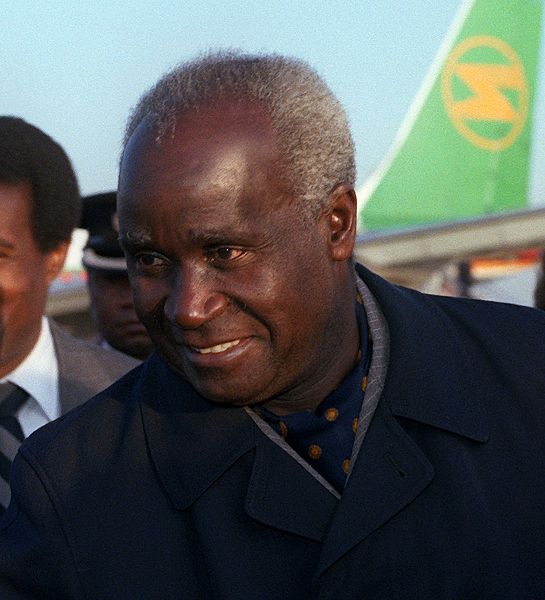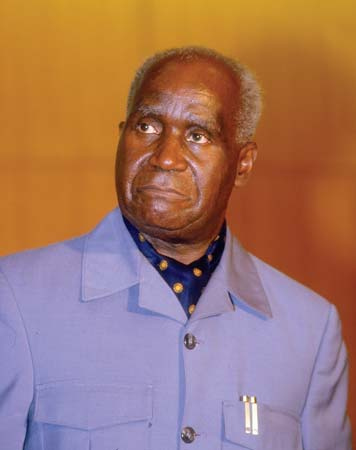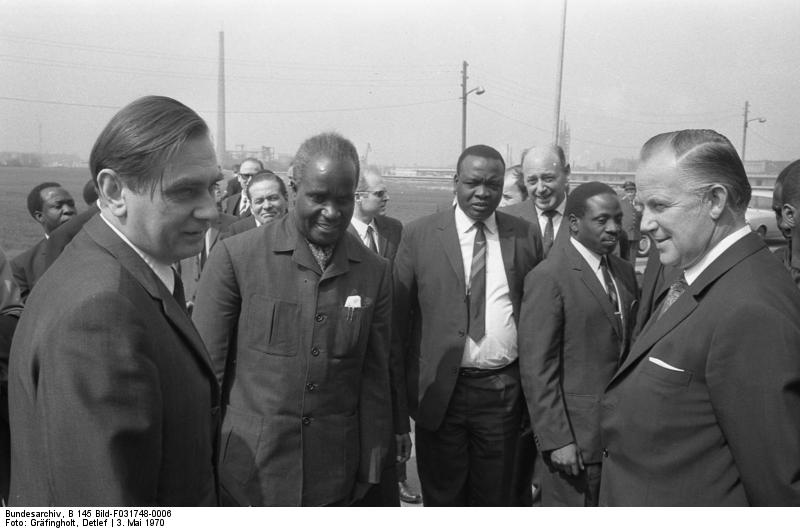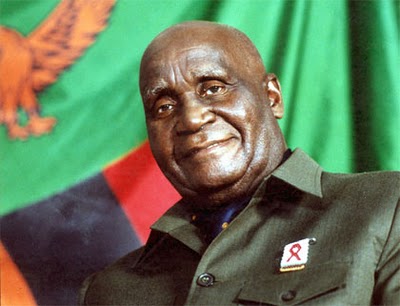<Back to Index>
- Chemist Franz Karl Achard, 1753
- Novelist Nelle Harper Lee, 1926
- 1st President of Zambia Kenneth David Kaunda, 1924
PAGE SPONSOR


Kenneth David Kaunda, affectionately known as KK (born April 28, 1924) served as the first President of Zambia, from 1964 to 1991.
Kaunda was the youngest of eight children. He was born at Lubwa Mission in Chinsali, Northern Province of Northern Rhodesia, now Zambia. His father was the Reverend David Kaunda, an ordained Church of Scotland missionary and teacher, who was born in Malawi and had moved to Chinsali to work at Lubwa Mission. He attended Munali Training Centre in Lusaka (August 1941 – 1943).
Kaunda
was a teacher at the Upper Primary School and Boarding Master at Lubwa
and then Headmaster at Lubwa from 1943 to 1945. He was for a time
working at the Salisbury and Bindura Mine. In early 1948, he became a teacher in Mufulira for
the United Missions to the Copperbelt (UMCB). He was then assistant at
an African Welfare Centre and Boarding Master of a Mine School in
Mufulira. In this period, he was leading a Pathfinder Scout Group and
was Choirmaster at a Church of Central Africa Congregation. He was also
for a time Vice - Secretary of the Nchanga Branch of Congress.
In April 1949 Kaunda returned to Lubwa to become a part time teacher, but resigned in 1951. In that year he became Organising Secretary of the Northern Rhodesian African National Congress for Northern Province, which included at that time Luapula Province. On 11 November 1953 he moved to Lusaka to take up the post of Secretary General of the ANC, under the presidency of Harry Nkumbula. The combined efforts of Kaunda and Nkumbula failed to mobilize the indigenous African people against the White dominated Federation of Rhodesia and Nyasaland. In 1955 Kaunda and Nkumbula were imprisoned for two months with hard labour for distributing "subversive" literature. Such imprisonment and other forms of harassment were normal rites of passage for African nationalist leaders. The experience of imprisonment had a radicalizing impact on Kaunda. The two leaders drifted apart as Nkumbula became increasingly influenced by white liberals and was seen as being willing to compromise on the issue of Black majority rule, waiting till the majority was 'ready' before extending the franchise. This was, however, to be determined by existing property and literacy qualifications, dropping race altogether. Nkumbula's allegedly autocratic leadership of the ANC eventually resulted in a split. Kaunda broke from the ANC and formed the Zambian African National Congress (ZANC) in October 1958. ZANC was banned in March 1959. In June Kaunda was sentenced to nine months' imprisonment, which he spent first in Lusaka, then in Salisbury (now called Harare).
While Kaunda was in prison, Mainza Chona and other nationalists broke away from the ANC and, in October 1959, Chona became the first president of the United National Independence Party (UNIP), the successor to ZANC. However, Chona did not see himself as the party's main founder. When Kaunda was released from prison in January 1960 he was elected President of UNIP. In July 1961 Kaunda organized a civil disobedience campaign in Northern Province, the so called Cha-cha-cha campaign, which consisted of burning schools and blocking roads. Kaunda ran as a UNIP candidate during the 1962 elections. This resulted in a UNIP–ANC Coalition Government, with Kaunda as Minister of Local Government and Social Welfare. In January 1964 UNIP won the General Election under the new Constitution beating the ANC under Nkumbula. Kaunda was appointed Prime Minister. On 24 October 1964 he became the first President of independent Zambia. Reuben Kamanga was appointed as the first Vice President.
In the year of independence, Kaunda had to deal with the independent Lumpa Church, led by Alice Lenshina in
Chinsali, his home district in the Northern Province. The Lumpa Church
tried to take up a neutral position in the political conflict between
UNIP and the ANC, but was then accused by UNIP of collaboration with
the White minority governments. Conflicts arose between UNIP youth and
Lumpa members, especially in Chinsali District, where the headquarters
of the church were. Kaunda, as Prime Minister of an African majority
Government, sent in two battalions of the Northern Rhodesia Regiment. The fight led to the deaths of about 1500 villagers and the flight to Katanga of tens of thousands of followers of Lenshina. Kaunda banned the Lumpa Church in August 1964 and proclaimed a state of emergency that was retained until 1991.
At the time of its independence, Zambia's modernization process was far from complete. It had just 109 university graduates and less than 0.5% of the population was estimated to have completed primary education. The nation's educational system was one of the most poorly developed in all of Britain's former colonies. Because of this, Zambia had to invest heavily in education at all levels. Kaunda instituted a policy where all children, irrespective of their parents' ability to pay, were given free exercise books, pens and pencils. The parents' main responsibility was to buy uniforms, pay a token "school fee" and ensure that the children attended school. This approach meant that the best pupils were promoted to achieve their best results, all the way from primary school to university level. Not every child could go to secondary school, for example, but those who did were well educated.
The University of Zambia was opened in Lusaka in 1966, after Zambians all over the country had been encouraged to donate whatever they could afford towards its construction. Kaunda was appointed Chancellor and officiated at the first graduation ceremony in 1969. The main campus was situated on the Great East Road, while the medical campus was located at Ridgeway near the University Teaching Hospital. In 1979 another campus was established at the Zambia Institute of Technology in Kitwe. In 1988 the Kitwe campus was upgraded and renamed the Copperbelt University, offering business studies, industrial studies and environmental studies. The University of Zambia offers courses in agriculture, education, engineering, humanities and social sciences, law, medicine, mining, natural sciences, and veterinary medicine and Computer Sciences. The basic program is four years long, although engineering and medical courses are five and seven years long, respectively.
Other
tertiary level institutions established during Kaunda's era were
vocationally focused and fell under the aegis of the Department of
Technical Education and Vocational Training. They include the Evelyn
Hone College of Applied Arts and Commerce and the Natural Resources
Development College (both in Lusaka), the Northern Technical College at
Ndola, the Livingstone Trades Training Institute in Livingstone, and
teacher training colleges.
At independence Kaunda received a country with an economy that was completely under the control of foreigners. For example, the British South Africa Company (BSAC, originally setup by the British imperialist Cecil Rhodes) retained commercial assets and mineral rights that it claimed it acquired from a concession signed with the Litunga of Bulozi in 1890 (the Lochner Concession). Only by threatening to expropriate it, on the eve of independence, did Kaunda manage to get the BSAC to assign its mineral rights to the incoming Zambian government. During the Federation, Northern Rhodesia's copper revenues were siphoned off by White Southern Rhodesians, since they were the dominant group in the polity. In their view, Southern Rhodesia was well suited to providing managerial and administrative skills, Northern Rhodesia would provide the copper revenues, and Nyasaland would provide the labour. At independence, Salisbury, the capital of Southern Rhodesia, was much more developed than Lusaka, the capital of Zambia. This was what Northern Rhodesians called the "bamba zonke" ("grab everything" in Fanakalo) greed of White Southern Rhodesians.
Following in the steps of the Soviet Union, Zambia instituted a program of national development plans, under the direction of the National Commission for Development Planning: the Transitional Development Plan was followed by the First National Development Plan (1966 – 71). These two plans, which provided for major investment in infrastructure and manufacturing, were largely implemented and were generally successful. This was not true for subsequent plans.
A major switch in the structure of Zambia's economy came with the Mulungushi Reforms of April 1968: the government declared its intention to acquire an equity holding (usually 51% or more) in a number of key foreign owned firms, to be controlled by the Industrial Development Corporation (INDECO). By January 1970, Zambia had acquired majority holding in the Zambian operations of the two major foreign mining corporations, the Anglo American Corporation and the Rhodesia Selection Trust (RST); the two became the Nchanga Consolidated Copper Mines (NCCM) and Roan Consolidated Mines (RCM), respectively. Kaunda announced the creation of a new parastatal body, the Mining Development Corporation (MINDECO). The Finance and Development Corporation (FINDECO) allowed the Zambian government to gain control of insurance companies and building societies. The foreign owned banks, such as Barclays, Standard Chartered and Grindlays, successfully resisted takeover. In 1971, INDECO, MINDECO, and FINDECO were brought together under an omnibus parastatal, the Zambia Industrial and Mining Corporation (ZIMCO), to create one of the largest companies in sub-Saharan Africa, with Kaunda as Chairman of the Board. The management contracts under which day-to-day operations of the mines had been carried out by Anglo American and RST were ended in 1973. In 1982 NCCM and RCM were merged into the giant Zambia Consolidated Copper Mines Ltd (ZCCM).
Unfortunately for Kaunda and Zambia, these programs of nationalization, even assuming they could have worked, were ill-timed. Events that were beyond their control would wreck the country's plans for national development. In 1973 the massive increase in the price of oil was followed by a slump in copper prices in 1975 and a diminution of export earnings. In 1973 the price of copper accounted for 95% of all export earnings; this halved in value on the world market in 1975. By 1976 Zambia had a balance-of-payments crisis, and rapidly became massively indebted to the International Monetary Fund (IMF). The Third National Development Plan (1978 – 83) had to be abandoned as crisis management replaced long-term planning.
By the mid-1980s Zambia was one of the most indebted nations in the world, relative to its gross domestic product (GDP). The
IMF was insisting that the Zambian government should introduce programs
aimed at stabilizing the economy and restructuring it to reduce
dependence on copper. The proposed measures included: the ending of
price controls; devaluation of the kwacha (Zambia's
currency); cut-backs in government expenditure; cancellation of
subsidies on food and fertilizer; and increased prices for farm
produce. Kaunda's removal of food subsidies caused massive increases in
the prices of basic foodstuffs; the country's urban population rioted
in protest. In desperation, Kaunda broke with the IMF in May 1987 and
introduced a New Economic Recovery Programme in 1988. However, this did
not help him and he eventually moved toward a new understanding with
the IMF in 1989. In 1990, with the collapse of the Soviet Union and
Eastern Europe (on which Kaunda’s ideology, Zambian Humanism had been
fashioned),
Kaunda was forced to make a major policy shift: he announced the
intention to partially privatize the parastatals. However, these
changes came too late to prevent his fall from power, which was largely
the result of the economic troubles.
In 1964 there was the Lumpa Uprising in Northern Zambia, four months before independence. Kaunda had a state of emergency declared which was not repealed until his fall from power. The state of emergency gave Kaunda absolute power. The Lumpa Church was destroyed and banned. It was a major source of opposition because it refused to allow church members to participate in politics which went against the 100% participation wanted by UNIP. This created a lot of animosity between the two groups and violence that began on a small scale escalated into a small civil war in which more than a thousand people were killed. The crisis was brought about by a combination of complacency on the part of the Colonial administration and UNIP intransigence. Kaunda tried to mediate the differences between the Church, local authorities and UNIP party members but was eventually unable to control party cadres in the North.
Becoming increasingly intolerant of opposition, Kaunda banned all parties except UNIP, following violence during the 1968 elections. In 1972, he made Zambia a one-party state, probably because he was worried by Simon Kapwepwe's decision to leave UNIP and found a rival party, the United Progressive Party, which Kaunda immediately banned. Next, he appointed the Chona Commission, which was set up under the chairmanship of Mainza Chona in February 1972. Its task was to make recommendations for the constitution of a 'one-party participatory democracy' (i.e. a one-party state). The Commission's terms of reference did not permit it to discuss the pros and cons of Kaunda's decision. The sole surviving opposition party, the ANC, boycotted the Commission and unsuccessfully challenged the constitutional change in the courts. The Chona report was based on four months of public hearings and was submitted in October 1972. It was widely regarded as a 'liberal' document. Finally, Kaunda neutralised Nkumbula by getting him to wind-up the ANC, join UNIP and sign a document called the Choma Declaration on 27 June 1973. The ANC ceased to exist after the dissolution of parliament in October 1973. Allegedly Kaunda "bought off" Nkumbula by offering him an emerald mine.
With no more opposition against him, Kaunda allowed the creation of a personality cult.
He developed a left nationalist - socialist ideology, called Zambian
Humanism. This was based on a combination of mid twentieth century
ideas of central planning - state control and what he considered basic
African values: mutual aid, trust and loyalty to the community. Similar
forms of African socialism were introduced inter alia in Ghana by Kwame Nkrumah ("Consciencism") and Tanzania by Julius Nyerere ("Ujamaa"), while in Zaire, President Mobutu Sese Seko was at a loss until he hit on the ideal ideology - 'Mobutuism'. To elaborate his ideology, Kaunda published several books: Humanism in Zambia and a Guide to its Implementation, Parts 1, 2 and 3. Other publications on Zambian Humanism are: Fundamentals of Zambian Humanism, by Timothy Kandeke; Zambian Humanism, religion and social morality, by Cleve Dillion - Malone S.J. and Zambian Humanism: some major spiritual and economic challenges, by Justin B. Zulu.
Although it was Kaunda's nationalization of the copper mining industry in the late 1960s that led to increased economic problems, matters were made worse by his economic and logistical support for the Black freedom fighters in the region: South Africa, the Portuguese colonies of Portuguese West Africa (now Angola) and Portuguese East Africa (now Mozambique) and Rhodesia (now Zimbabwe). Kaunda tried to solve the conflict in Southern Africa between the White minority governments of Rhodesia, South Africa and Angola and Mozambique and the African freedom fighters by mediation and boycotts.
On 25 – 26 August 1976, Kaunda met with the Prime Minister of South Africa, B.J. Vorster at Victoria Falls and again on 30 April 1982 with Prime Minister, Pieter Willem Botha on the Botswana border to discuss the political situation in South West Africa and South Africa. However, he did not manage to get serious concessions from the South
African government. Kaunda was criticised in the African press for
talking to representatives of the apartheid regime.
During his early presidency he was an outspoken supporter of the anti-apartheid movement and opposed Ian Smith's white minority rule in Rhodesia. Kaunda allowed several African liberation fronts such as ZAPU and ZANU of Rhodesia and African National Congress to set headquarters in Zambia. Former ANC president Oliver Tambo spent a significant proportion of his 30 year exile living and working in Zambia. Joshua Nkomo the leader of ZAPU also stationed a military base in Zambia. In retaliation the white minority governments of Rhodesia and South Africa carried out espionage and frequently executed bombing attacks in Zambia. Herbert Chitepo, prominent ZANU leader, was killed with a car bomb in Lusaka in 1975. The struggle in both Rhodesia and South Africa and its offshoot wars in Namibia, Angola and Mozambique placed a huge economic burden on Zambia as these were the country's main trading partners. As a response, Kaunda negotiated the TAZARA Railway (Tanzam) linking Kapiri Mposhi on the Zambian Copperbelt with Tanzania's port of Dar-es-Salaam on the Indian Ocean. Completed in 1975, this was the only route for bulk trade which did not have to transit white controlled territories. This precarious situation lasted more than 20 years, until the end of apartheid in South Africa. When Nelson Mandela was released from prison in 1990, the first country he visited was Zambia on 27 February.
During the Cold War, Kaunda was a strong supporter of the Non-Aligned Movement. He hosted a NAM summit in Lusaka in 1970 and served as the movement’s chairman from 1970 to 1973. He maintained a close friendship with Yugoslavia's long time leader Josip Broz Tito and is remembered by many former citizens of Yugoslavia for weeping openly over his casket in 1980. He even had a house built in Lusaka for Tito's visits to the country. Kaunda had frequent but cordial differences with US President Ronald Reagan whom he met 1983 and Margaret Thatcher mainly over what he saw as the West's blind eye to apartheid. He always maintained warm relations with the People's Republic of China who had provided assistance on many projects in Zambia including the TAZARA Railway.
In the late 1980s prior to the first Gulf War Kaunda developed a friendship with Saddam Hussein with whom he struck various agreements to supply oil to Zambia. He named streets in Saddam's honour (Saddam Hussein blvd., now Los Angeles blvd.). During the events that led to the Gulf War, Saddam became increasingly isolated.
In August 1989 Farzad Bazoft was arrested in Iraq for alleged espionage. He was accompanied by a British nurse, Daphne Parish who was arrested as well. Bazoft was an Iranian born British freelance journalist
who was about to expose Saddam's gassing of the Kurds. Bazoft was later
tried, sentenced to death and executed. Parish was sentenced to 15
years in prison. But in 1990 just as the Gulf War was about to break
out Kaunda successfully managed to negotiate the release of Parish with
Saddam. Kaunda served as chairman of the Organization of African Unity (OAU) from 1970 to 1973.
After promulgation of the Second Republic, following Mainza Chona's recommendations for the constitution of a "one-party participatory democracy", Kaunda's leadership took on more autocratic characteristics, and he in fact became a "dictator" in the purest sense of the definition of the word. He personally appointed the Central Committee of UNIP, although the process was given a veneer of legitimacy by being "approved" by a National Congress of the party. In theory, Kaunda's nominations could be discarded by Congress, but in practice they were always accepted without modification. The argument used was that "the President knows the people who can work well with him, so if we modify the nominations we will end up with a less effective team". In turn, the Central Committee nominated a sole candidate for the post of President of the party. Of course, since the members of the Central Committee had been nominated by him, Kaunda was always the sole presidential candidate.
After that charade, the rest of the Zambian population was given the opportunity to express approval or disapproval of the sole candidate's nomination by voting either "Yes" or "No". Since the presidential "election" was always accompanied by parliamentary elections, there was great pressure placed on parliamentary candidates to "campaign" for the president's "Yes" vote, in addition to their own campaigns. Parastatals companies (which were controlled through ZIMCO - Zambia Industrial and Mining Corporation) were also under pressure to "campaign" for Kaunda by buying advertising space in the two national newspapers (Times of Zambia and Zambia Daily Mail) exhorting the electorate to give the president a "massive 'Yes' vote".
The parliamentary elections were also controlled by Kaunda: the names of candidates had to be submitted to UNIP's Central Committee, which then selected three people to stand for any particular constituency. Anyone could be vetoed without the Central Committee giving any reason, since UNIP was supreme and its decisions were unchallengeable. Using these methods, Kaunda kept any enemies at bay by ensuring that they never got into political power.
This was the tactic he used when he saw off Nkumbula and Kapwepwe's challenges to his sole candidacy for the 1978 UNIP elections. On that occasion, the UNIP's constitution was "amended" overnight to bring in rules that invalidated the two challengers' nominations: Kapwepwe was told he could not stand because only people who had been members for five years could be nominated to the presidency (he had only rejoined UNIP three years before); Nkumbula was outmaneuvered by introducing a new rule that said each candidate needed the signatures of 200 delegates from each province to back his candidacy. Less creative tactics were used on a third candidate called Chiluwe; he was just beaten up by the UNIP Youth Wing to within an inch of his life. This meant that he was in no state to submit his nomination.
Eventually,
however, economic troubles and increasing international pressure to
bring more democracy to Africa forced Kaunda to change the rules that
kept him in power. People who had been afraid to criticise him were now
emboldened to challenge his competence. His close friend Julius Nyerere had
stepped down from the republican presidency in Tanzania in 1985 and was
quietly encouraging Kaunda to follow suit. Pressure for a return to
multiparty politics increased and Kaunda voluntarily yielded and called
for multiparty elections in 1991, in which the Movement for Multiparty Democracy (MMD) won. One of the issues in the campaign was a plan by Kaunda to turn over one quarter of the nation's land to Maharishi Mahesh Yogi,
an Indian guru who promised that he would use it for a network of
utopian agricultural enclaves that proponents claimed would create
"heaven of earth". Kaunda was forced in a television interview to deny practicing Transcendental Meditation. Kaunda left office with the inauguration of MMD leader Frederick Chiluba as
president on November 2, 1991. He was the second mainland African head
of state to allow free multiparty elections and to have relinquished power when he lost: the first, Mathieu Kérékou of Benin, had done so in March of that year.
Chiluba later attempted to deport Kaunda on the grounds that he was a Malawian. The MMD dominated government under the leadership of Chiluba had the constitution amended, barring citizens with foreign parentage from standing for the presidency, to prevent Kaunda from contesting the next elections in 1996, and Kaunda retired from politics after he was accused of involvement in a failed 1997 coup attempt. In 1999 Kaunda was declared stateless by the Ndola High Court in a Judgment delivered by Mr. Justice Chalendo Sakala. A full transcript of the judgment was published in the Times of Zambia edition of 1 April 1999. Kaunda however successfully challenged this decision in the Supreme Court of Zambia, which declared him to be a Zambian citizen in the year 2000.
After retiring, he has been involved in various charitable organizations. His most notable contribution has been his zeal in the fight against the spread of HIV/AIDS. One of Kaunda's children was claimed by the pandemic in the 1980s. From 2002 to 2004, he was an African President-in-Residence at the African Presidential Archives and Research Center at Boston University.
Recently, he was seen in the attendance of an episode of Dancing With The Stars as Kaunda is an avid ballroom dancer.
On 19 October 2007 Kaunda was the recipient of the 2007 Ubuntu Award.

